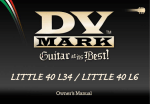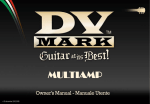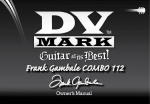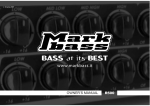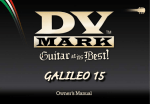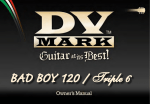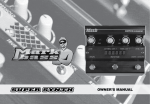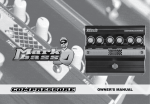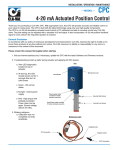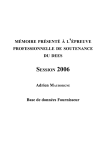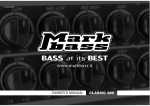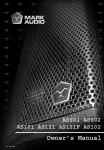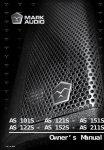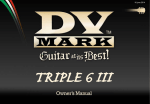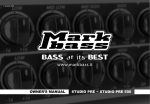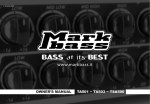Download DV Mark Combo head 40 Technical information
Transcript
SAFETY INSTRUCTIONS 1. IMPORTANT SAFETY INSTRUCTIONS 1) Read these instructions; 2) Keep these instructions; 3) Heed all warnings; 4) Follow all instructions; 5) Do not use this apparatus near water; 6) Clean only with a dry cloth; 7) Install in accordance with the manufacturer’s instructions; 8) Do not install near any heat sources such as radiators, heat registers, stoves, or other apparatuses (including amplifiers) that produce heat; 9) Protect the power cord from being walked on or pinched, particularly at plugs, convenience receptacles, and the point where they exit from the apparatus; 10) Only use attachments/accessories specified by the manufacturer; 11) Unplug this apparatus during lightning storms or when unused for long periods of time; 12) Refer all servicing to qualified service personnel. Servicing is required when the apparatus has been damaged in any way, such as when the power-supply cord or plug is damaged, liquid has been spilled or objects have fallen into the apparatus, or when the apparatus has been exposed to rain or moisture, does not operate normally, or has been dropped; 13) “Warning: to reduce the risk of fire or electric shock, do not expose this apparatus to rain or moisture; and objects filled with liquids, such as vases, should not be placed on this apparatus”; 14) The socket outlet shall be installed near the equipment and shall be easily accessible; 15) The power cord must be unplugged prior to servicing 1. PRÉCAUTIONS D’EMPLOI 1) Lire ces instructions; 2) Conserver ces instructions; 3) Suivre tous les conseils d’utilisations; 4) Suivre toutes les instructions; 5) Ne pas utiliser cet appareil au bord de l’eau; 6) Nettoyer uniquement avec un chiffon humide; 7) Ne pas bloquer le système de ventilation. Installer conformément aux instructions du fabricant; 8) Ne pas installer l’appareil près d’une source de chaleur tel qu’un radiateur, un fourneau, ou bien un autre appareil qui produit de la chaleur; 9) Protéger le cordon d’alimentation afin qu’il ne soit pas piétiné ou écrasé tout particulièrement au niveau des fiches, des prises de courant femelles, et des parties qui sortent de l’appareil; 10) Utiliser uniquement les accessoires recommendés par le fabricant; 11) Ne pas branché l’appareil en cas d’orage accompagné d’éclairs. Le débrancher en cas de non utilisation prolongée; 12) S’adresser à un service assistance agréé si l’appareil a subi des dommages, si le cordon d’alimentation ou la fiche a été endommagé, si un liquide a été renversé sur l’appareil ou bien si un object est tombé dans l’appareil, si ce dernier a été exposé à la pluie ou à l’humidité, s’il ne fonctionne pas correctement ou s’il est tombé; 13) “Avertissant: pour réduire le risque du feu ou de décharge électrique, n’exposez pas cet appareil à la pluie ou l’humidité et les objets remplis de liquides; tels que des vases, ne devraient pas être placés sur cet appareil”; 14) La prise de courant doit être installée près de l’appareil et doit être facilement accessible; 15) La fiche principale doit être débranchée avant toute opération d’entretien MORE INFORMATION For warranty and service information, please contact your local DV Mark distributor (contact information available at www.dvmark.it). For more technical information, please visit us at www.dvmark.it and fill out the form on the Contact Us page. We hope you enjoy your amplifier and use it to make great music! “The Lightning Flash with arrowhead symbol within an equilateral triangle, is intended to alert the user to the presence of uninsulated “dangerous voltage” within the product enclosure that may be of sufficient magnitude to constitute a risk of shock to persons.” “The exclamation point within an equilateral triangle is intended to alert the user to the presence of important operating and maintenance (servicing) instructions in the literature accompanying the product.” 2 A Word from Marco De Virgiliis MARK VISION Thank you for choosing DV Mark! We are very excited to have you join us for an exciting new chapter in the history of guitar amplification. In less than 10 years, we have succeeded in making Markbass the world’s leading bass amp brand, using technology to better serve the needs of bassists: great tone, reliability, versatility/flexibility, and light weight. Now it’s time for guitarists to have their turn! The classic tones guitarists have come to know and love over the last few decades are worthy of great respect. We have designed our amps with a great reverence for these sounds. We’re not trying to start a revolution in guitar tone… because guitarists don’t want or need that. However—there are some important areas where the classic amplifiers can be greatly improved upon, to better suit the needs of guitarists: The first is reliability—and we are very proud of the high quality standard that we’re able to offer thanks to our 100% Made in Italy production, state-of the-art testing and quality control facilities, top-quality components, and innovative technology that makes it easy to monitor the condition of your amp and its tubes. You need to be able to always trust your amp… and we understand that! The second is flexibility. One example of this is DV Mark’s patent pending Continuous Power Control feature (included on our 40W heads and combos), which allows you to adjust the power incrementally, setting the power at anywhere between 1 and 40W. This means you can get the tone you want at the volume you need; so you can use the same amp for everything, from larger gigs, to smaller gigs, right down to bedroom practicing—and never sacrifice your tone! The third is light weight. Many of you have seen your bass players easily loading in and out of gigs with their lightweight Markbass gear, while you struggle with a heavy 2x12 combo or 4x12 cabinet. It’s time you enjoyed the same benefits of lightweight gear! Especially if you play a lot, the weight of your gear is a real factor. Once you learn that DV Mark allows you to get killer tone at a fraction of the weight… there’s no going back. We hope you will enjoy your new guitar amp, and we invite you to contact us any time with your comments and questions, at [email protected]. Thanks again, and good music! Marco De Virgiliis 3 FRONT PANEL 1) INPUT CH1 (Hi Z 1MΩ) Connect your guitar to this input using a standard ¼” shielded instrument cable. This input is suitable for instruments that have normal-output pickups and passive electronics. 2) INPUT CH2 (Low Z -6dB) This input is padded by 6 dB to compensate for higher output sources, and is suitable for use with guitars that have high-output pickups or active electronics. 3) NORMAL/BRIGHT This switch boosts upper-treble frequencies, adding brightness to your sound. This is often used to compensate for the loss of brightness that occurs when the amp is being used at low volumes. 4) GAIN (CLEAN CHANNEL) This knob sets the gain level, and is the preamp’s most powerful control. It not only determines the amount of drive or saturation (for getting clean, crunch or overdriven sounds, or anywhere in between), but also plays an important role in tone shaping. 5) MASTER (CH1) This control is the master feed from the end of the preamp channel to the tube power stage. It allows you to obtain a wide range of sounds/ colours in relation to the gain setting—for example, very low gain sounds at high volumes or high gain sounds at low volumes. 6) SWITCH CH1/CH2 This channel selector switches between the Clean (CH1) and Drive (CH2) channels. Channel-switching can also be controlled by the “Clean/ Drive” footswitch that can be plugged into the combo’s top panel (19): the channel selector switch is disabled when a footswitch is connected to the footswitch jack. 7) DRIVE Controls how much preamp overdrive and saturation is applied in Drive mode (CH2), ranging from crunch to overdrive sounds. 4 8) MASTER (CH2) This control is the master feed from the end of the preamp channel to the tube power stage. It allows you to obtain a wide range of sounds/ colours in relation to the gain setting—for example, very low gain sounds at high volumes or high gain sounds at low volumes. 9) BASS This knob controls the amount of low frequencies in your sound. When you’re starting to explore sounds on the amp, avoid boosting the lows too much as this can reduce your attack and muddy your sound—especially as you turn up your gain. 10) MIDDLE The Middle control regulates the midrange frequencies and is an important part of your tone shaping. The frequency range it boosts and cuts has a big effect on the character of your sound. For a more scoopy tone, lower the mids. Turn the knob up for more focused attack and better pitch definition. 11) HIGH The High knob controls how much of the preamp’s high frequencies are blended into the signal. It can produce unwanted noise (hiss) or pickup feedback if really cranked, so it’s best to avoid extreme settings. 12) RIVERBERO Level control for the onboard Accutronics® spring reverb. 13) PRESENCE The Presence knob controls high frequencies, above those controlled by the High knob. It’s an effective and useful part of the amp’s tone controls. Turn the Presence up for crisp, sparkling clean sounds, crunchy rhythm sounds and aggressive riffs; lower it for darker, rounder sounds and focused single-note lead tones. 14) SOLO This control can be activated by footswitch. It boosts your signal level by 6 dB to step up your volume for lead playing in live performance. 5 FRONT PANEL 15) CONTINUOUS POWER CONTROL (CPC) This patent pending feature allows you to change the actual power of the amp, from full power 40W (class A/B) gradually down to 1W (class A) in Pentode mode—or 15W (class A/B) to 0.5W (class A) in Triode mode. This allows users to get the tone they want at any volume for any musical situation. 16) STANDBY Before powering on, make sure this switch is in standby position. When you turn on the power, the microcontroller waits for the tubes to heat up before turning on the plate voltage. The “power on” LED will flash for 30 seconds before the amp is ready. When the LED stops blinking, flip the Standby switch to the ON position. Between sets or whenever you’re on a break from playing, put the amp in standby position (down). 17) POWER This switch delivers AC power to the amp. Make sure the unit is grounded; all three terminals of the AC power plug must be connected to avoid any injury to the user or damage to the unit. DV Mark amps and combos are manufactured to be used in the country where they have been sold, and are factory preset to that country’s voltage. So make sure you’re sending the correct voltage to your amp before connect it to AC power. Follow the procedure described in the STANDBY section above (16) before powering up your amp. 18) PRE OUT – AMP IN The combo features a series preamp output and power amp input which can be used for connecting with outboard effect processors or pedals. This loop is wired between the preamp and the power amp, and its level is optimized to match well with most quality effect processing devices. Simply connect the Pre Out jack to your processor’s input, and connect the output of your processor to the Amp In jack. You can also use the Pre Out to send to another power amp, recording device, DI, etc. 19) FSW 1/4” STEREO jack for connecting a DUAL footswitch to switch between Clean and Drive channels and activate the solo boost. 6 FRONT PANEL 18 4 1 2 3 5 7 6 8 9 10 11 12 13 19 15 16 17 14 7 REAR PANEL 20) SPEAKER OUTS One 4 ohm, one 8 ohm and one 16 ohm jack are provided for speaker cabinet connections. Verify the impedance of your speaker cabinet to make sure you connect it to the correct output. 21) TUBE MODE This switch allows you to switch between the two tube operating modes, Pentode and Triode. Each mode has different power outputs: Pentode: 1 ÷ 40W (from 1W class A to 40W class AB) Triode: 0,5 ÷ 15W (from 0,5W class A to 15W class AB) 22) BIAS switch (low/high) The Combo Head 40 can operate in either Low Bias mode or High Bias mode. When this button is pressed in the power tubes work in High Bias mode; when the button is depressed they work in Low Bias mode. In Low Bias mode, the tubes use less power and less ‘tube life’ is taken out of them. High Bias mode gives top quality and power, and higher-fidelity sound—but the power consumption and dissipation of the tubes increases. In either mode, unlike other tube amplifiers, the Combo Head 40 is able to greatly prolong the life of its tubes by keeping them optimally biased at all times. 23) SERVICE The optional ATCS (Advanced Tube Control System) interface allows users or service technicians to connect this port to a computer— and with dedicated software—collect technical data and tube parameters from the amp. 24) AC Power Socket Make sure the unit is grounded; all three terminals of the AC power cord must be connected to avoid any injury to the user or damage to the unit. DV Mark amps and combos are manufactured to be used in the country where they have been sold, and are factory preset to that country’s voltage. So make sure you’re sending the correct voltage to your amp before you connect it to AC power. 8 REAR PANEL 22 24 23 21 20 9 TECHNICAL SPECS Power Output (CPC): . . . . . . . . . Pentode: 1 ÷ 40W . . . . . . . . . Triode: 0,5 ÷ 15W Preamp Tubes: 2x ECC83 Power Tubes: 2x EL34 1x ECC83 Channels: TWO Controls: Gain - Master - Presence - Solo - Continuous Power Control (CPC) EQ Controls: Low - Mid - High (passive) Speaker Outputs: . . . . . . . . . One 4 ohm . . . . . . . . . One 8 ohm . . . . . . . . . One 16 ohm Other Features: . . . . . . . . . input 1 (Hi Z 1MΩ), input 2 (Low Z - 6dB) . . . . . . . . . Service ATCS intervace (optional) POWER REQUIREMENT: (Voltage is factory preset according to region of sale) 100V/120V; 230V; 240V 50/60Hz DV Mark amps/combos are manufactured to be sold and used in the country of purchase, and they are factory preset to that country’s voltage. Due to homologation issues, the voltage may not be changed. 10 TECHNICAL SPECS DV 40 112 COMBO Speaker size: 1x12” B&C Neodymium DV Mark Custom Speaker power handling: 150W (AES standard) impedance 8 ohms Dimensions: 628 x 465 x 272 mm / 24.72” x 18.31” x 10.71” Weight: 15,9 kg / 35.05 lbs DV 40 212 COMBO Speaker size: 2x12” B&C Neodymium DV Mark Custom Speaker power handling: 300W (AES standard) impedance 4 ohms Dimensions: 684 x 465 x 272 mm / 26.93” x 18.31”x 10.71” Weight: 17 kg / 37.48 lbs 11 BLOCK DIAGRAM ½ ECC83 Bright ½ ECC83 HiZ CH1/CH2 CH1/CH2 HPF Master 2 ½ ECC83 ½ ECC83 Passive tone control LowZ Solo Gain Master 1 Low Mid High Power amp Reverb EL34 Pre Out Rev ECC83 16 ohm Output transformer + Amp In 8 ohm 4 ohm EL34 Presence Microcontroller CPC Standby Pentode/Triode Bias Service mains fuse Power Supply On/Off 12 CH1/CH2 LIMITED WARRANTY 13 WARRANTY CARD 10 JULY 2010 DV MARK PRODUCT LINE Heads Bad Boy 120 120W, 3-channel, all-tube rock head Little 40 40W, 1-channel all-tube head with CPC* and 6L6 or EL34 power tubes Galileo 15 15W, 1-channel all-tube head Cabinets C 112 Small 1x12”, super compact and lightweight; 7.6 kg / 16.7 lbs 150W, 8 ohms C 112 Standard 1x12”, horizontal; 8.8 kg / 19.4 lbs; 150W, 8 ohms Pedals Guitar Tube Marker Distortion pedal for guitar DVM Compressore Tube compressor pedal for guitar C 212 Standard 2x12”, horizontal; 10.3 kg / 22.7 lbs 300W, 4 ohms mono / 2x8 ohms stereo Combos DV40 112 2-channel, 1x12”, 40W all-tube combo with CPC*, boost and Accutronics reverb DV40 212 2-channel, 2x12”, 40W all-tube combo with CPC*, boost and Accutronics reverb C 212 V 2x12”, vertical slant-top design; 13.5 kg / 29.7 lbs, 300W, 4 ohms C 412 Standard 4x12”, standard slant-top design; 21.4 kg / 47.1 lbs, 600W, 8 ohms mono / 2x16 ohms stereo C 412 Vintage 4x12”, flat front vintage design, 19.7 kg / 43.4 lbs 600W, 8 ohms mono / 2x16 ohms stereo *CPC = Continuous Power Control 11 Product specifications are subject to change without notice TM www.markbass.it TM www.momark.it www.markaudio.it srl Italy - 66020 San Giovanni Teatino CH - Via Po, 52 Tel: +39 0854407764 / 0854465705 - Fax: +39 0854407764 / 0854407399 - www.dvmark.it - [email protected]
















